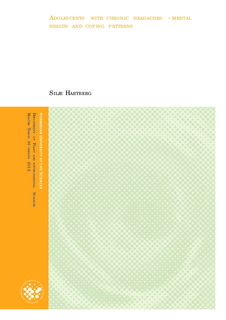Adolescents with chronic headaches : mental health and coping patterns
Master thesis
Permanent lenke
http://hdl.handle.net/11250/189694Utgivelsesdato
2012-09-10Metadata
Vis full innførselSamlinger
- Master's theses (IPM) [204]
Sammendrag
The purpose of this study is to investigate coping strategies in adolescents with chronic headaches with and without mental health problems. An additional aim is to investigate the comorbidity of mental health problems in chronic headache sufferers, and whether some types of mental health problems in adolescents are more strongly associated with chronic headaches, than others.
This study is based on a self-report cross-sectional study undertaken in Akershus County in Norway in 2002. A total of 19 985 adolescents in lower secondary school and upper secondary school, aged 13-19 years, are included in this study.
Statistical analyses were performed with SPSS version 17.0. The analyses showed that chronic headaches among youth were associated with a higher risk of having mental health problems and vice versa. Furthermore, the analyses showed that, hyperactivity and emotional problems were the most common comorbid mental health problems in chronic headache sufferers.
Youth with chronic headaches and with additional mental health problems were more likely to use maladaptive internal coping strategies, like keeping feelings inside, using drugs and talking oneself out of problems, compared to those having chronic headaches alone, and compared to the control group. Furthermore, the comorbid group was less likely to seek support in family or friends, while they were more likely to visit health care services. This study emphasizes the need for an increased focus on external coping strategies in adolescents, as well as a biopsychosocial approach when assessing the psychological and social impact of chronic headaches. This emphasis should enhance the long-term prognosis of the vulnerable comorbid group.
